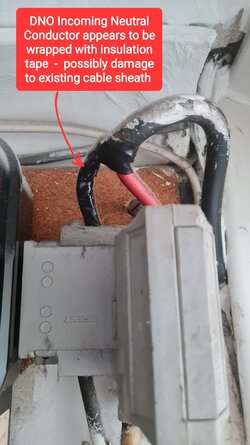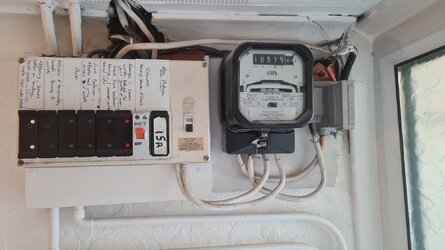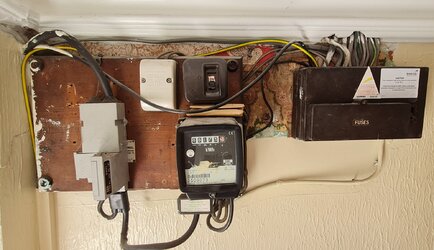- Nov 24, 2021
- 4
- 2
- 33
- If you're a qualified, trainee, or retired electrician - Which country is it that your work will be / is / was aimed at?
- United Kingdom
- What type of forum member are you?
- Practising Electrician (Qualified - Domestic or Commercial etc)
- Business Name
- APT Building and Electrical
Hi all, I am looking for some advice regarding old rewireable (3036) fuse boards in regards to additions and alterations. I am an electrician and have a relatively good understanding of the regulations, that said I have been working for myself until recently and now work for a company that completes disability adaptions including bathrooms, stairlifts, hoists etc. Previously when I encountered old rewireable fuse boards and the clients requirements were additional circuits or alterations to special locations I would either upgrade the existing system or turn the work away. My reasoning for this is adding separate consumer units for a kitchen, bathroom, outside lighting etc is nothing more than a "work around" to the installation and increased risk of customers or future electricians interconnecting between, complicated isolation of circuits/ areas within the property, any existing faults not rectified and so on. This is a personal preference only and I understand that not all would agree with me and some may even claim I am scare mongering clients into unnecessary work and cost, but this is not the case.
I have encountered some existing rewireable fuse boards that in reality are in desperate need of updating and possibly a partial or full rewire in my opinion. I have attached 2 images that I hope will help.
• Example 1 -- TT arrangement, no main earth, no bonding on water (well, there is a 4mm cpc connected in board to a pipe upstairs under the boiler, but not what id consider suitable at all), no bonding to gas, charring/ blackening of cables, no 100ma rcd, sockets on lighting circuit with no cpc (old rubber singles) amongst other issues.
I am tasked with installing a switched fused spur for stairlift only
• Example 2 -- TT arrangement, incoming tails are different csa, enter the board at 3 separate places, no 100ma rcd, warning label from British Gas, upon arrival I noticed 3 x 2.5mm radial circuits supplied by 30A cartridges (I exchanged these to 15A and 20A), external lights that have the glass bezels open and damaged etc.
I am tasked with installing new 9.5kw electric shower, bathroom light, extractor fan
I have to arrange for the DNO to remove the main fuse at both properties including installation of new 100A main isolator. My question is, to my understanding a new CU woth spd and 30ma rcds do not require a 100ma rcd provided the incoming tails are secured to minimise them becoming loose, an 100ma time delay rcd would be needed if installed in front of the sub board (though a new CU with 30ma does not require this). If I install new main earthing to existing board it may create a "circuit" to earth if there are faults to the existing installation, any rcd installed in front of the existing installation will likely trip due to existing faults, should the existing tails (different csa) be replaced.
To what extent am I responsible for responsible to the existing installation?
Personally I wouldn't feel comfortable re connection of installations that I know have these issues, even though technically as I'm only working on the new sub boards and no alterations are made to the existing installation.
Any help or advice would be appreciated, thanks in advance
I have encountered some existing rewireable fuse boards that in reality are in desperate need of updating and possibly a partial or full rewire in my opinion. I have attached 2 images that I hope will help.
• Example 1 -- TT arrangement, no main earth, no bonding on water (well, there is a 4mm cpc connected in board to a pipe upstairs under the boiler, but not what id consider suitable at all), no bonding to gas, charring/ blackening of cables, no 100ma rcd, sockets on lighting circuit with no cpc (old rubber singles) amongst other issues.
I am tasked with installing a switched fused spur for stairlift only
• Example 2 -- TT arrangement, incoming tails are different csa, enter the board at 3 separate places, no 100ma rcd, warning label from British Gas, upon arrival I noticed 3 x 2.5mm radial circuits supplied by 30A cartridges (I exchanged these to 15A and 20A), external lights that have the glass bezels open and damaged etc.
I am tasked with installing new 9.5kw electric shower, bathroom light, extractor fan
I have to arrange for the DNO to remove the main fuse at both properties including installation of new 100A main isolator. My question is, to my understanding a new CU woth spd and 30ma rcds do not require a 100ma rcd provided the incoming tails are secured to minimise them becoming loose, an 100ma time delay rcd would be needed if installed in front of the sub board (though a new CU with 30ma does not require this). If I install new main earthing to existing board it may create a "circuit" to earth if there are faults to the existing installation, any rcd installed in front of the existing installation will likely trip due to existing faults, should the existing tails (different csa) be replaced.
To what extent am I responsible for responsible to the existing installation?
Personally I wouldn't feel comfortable re connection of installations that I know have these issues, even though technically as I'm only working on the new sub boards and no alterations are made to the existing installation.
Any help or advice would be appreciated, thanks in advance
Attachments
-
 20230511_141112.jpg247 KB · Views: 423
20230511_141112.jpg247 KB · Views: 423 -
 20230530_151951.jpg347.1 KB · Views: 150
20230530_151951.jpg347.1 KB · Views: 150 -
 20230530_151958.jpg376.7 KB · Views: 203
20230530_151958.jpg376.7 KB · Views: 203 -
 20230530_165447.jpg295.5 KB · Views: 217
20230530_165447.jpg295.5 KB · Views: 217 -
 20230530_165449.jpg315 KB · Views: 152
20230530_165449.jpg315 KB · Views: 152 -
 20230530_165458.jpg321 KB · Views: 153
20230530_165458.jpg321 KB · Views: 153 -
 20230530_165741.jpg293.3 KB · Views: 209
20230530_165741.jpg293.3 KB · Views: 209 -
 20230511_131504.jpg200.9 KB · Views: 148
20230511_131504.jpg200.9 KB · Views: 148 -
 20230511_131546.jpg248.1 KB · Views: 152
20230511_131546.jpg248.1 KB · Views: 152 -
 Screenshot_20230511_145557.jpg404.8 KB · Views: 144
Screenshot_20230511_145557.jpg404.8 KB · Views: 144 -
 20230511_124154.jpg253.6 KB · Views: 133
20230511_124154.jpg253.6 KB · Views: 133 -
 20230511_124132.jpg259.9 KB · Views: 199
20230511_124132.jpg259.9 KB · Views: 199 -
 20230511_124138.jpg237.3 KB · Views: 141
20230511_124138.jpg237.3 KB · Views: 141 -
 20230511_130907.jpg224.5 KB · Views: 145
20230511_130907.jpg224.5 KB · Views: 145 -
 20230511_131113.jpg172.3 KB · Views: 167
20230511_131113.jpg172.3 KB · Views: 167





 , it would seem that the DMO don't really care/interested in providing a usable earth to domestic properties, is it time for legislation for new builds to all have a TT supply, discuss?
, it would seem that the DMO don't really care/interested in providing a usable earth to domestic properties, is it time for legislation for new builds to all have a TT supply, discuss? 








